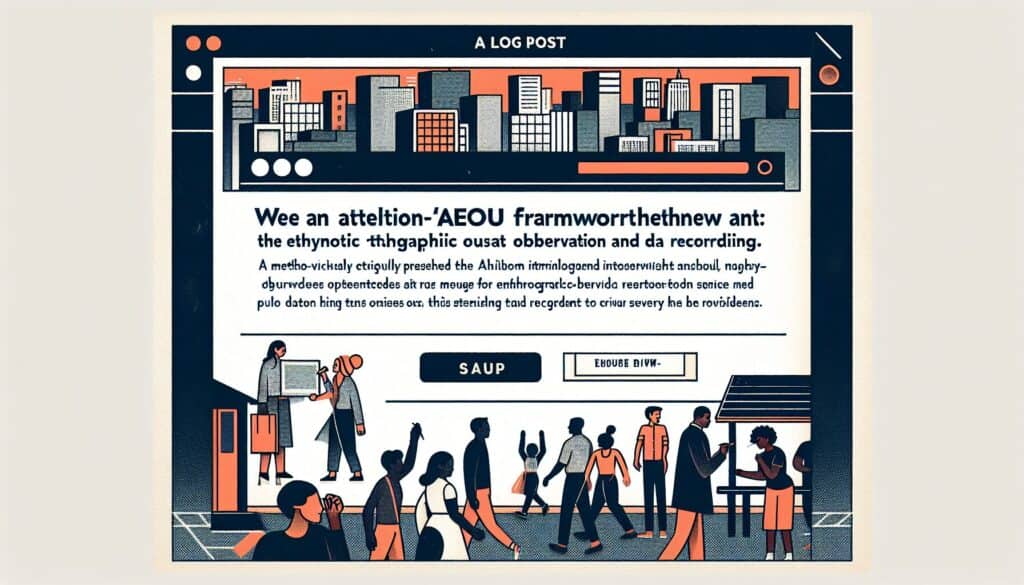指导人种学观察和数据收集,提供结构化的 框架 对环境和行为细节进行分类。
- 方法: 客户与营销, 构思, 产品设计
AEIOU 框架

AEIOU 框架
- 客户旅程制图, 设计思维, Human-Centered Design, 交互设计, 用户体验(UX), 以使用者為中心的設計
目标
如何使用
- 观察者记录活动(以目标为导向的行动)、环境(活动发生的背景)、互动(人、物或环境之间的互动)、物体(环境中的关键要素)和用户(被观察者、他们的角色和行为)。
优点
- 为实地观察提供了一个全面而简单的结构,有助于确保所有关键方面都得到考虑,促进系统的数据收集和分析,有助于发现潜在的用户需求。
缺点
- 彻底记录可能很费时,观察者可能会有偏差,可能会产生大量定性数据,需要进行大量的分析工作,有效性取决于观察者的技能。
类别
- 客户与营销, 人体工程学, 构思, 产品设计
最适合:
- 开展用户研究和人种学研究,深入了解用户行为、需求以及产品或服务的使用环境。
AEIOU 框架是一种通用方法,适用于消费电子、医疗保健设计和城市规划等多个领域。它在产品开发的早期阶段尤为有效,因为了解用户互动和环境条件可以为设计决策提供依据。用户研究人员、交互设计师和人种学家通常会启动这种方法,因为它需要与目标受众直接接触,观察并记录他们在真实环境中的行为。在实践中,团队可能会在家庭、医院或工作场所等环境中进行实地研究,这样就能捕捉到广泛的用户活动,同时注意到周围的环境和发生的互动。例如,在汽车行业,通过观察驾驶员在车内的活动,了解他们如何与控制装置互动以及如何在各种任务上花费时间,可以为改进设计提供信息,从而提高用户的安全性和舒适性。AEIOU 框架的结构化性质确保了用户体验的所有方面都被有条不紊地记录下来,从而支持全面的数据分析和未满足用户需求的识别,最终实现更相关、更实用的用户体验。 以用户为中心 产品解决方案。这种方法不仅能揭示用户行为的细微差别,还能捕捉产品的使用环境,在开发新功能或服务时有助于与用户期望产生共鸣。包括工程师和营销人员在内的多学科团队之间的合作可以利用 AEIOU 框架的研究成果,使产品开发与实际用户需求相一致,从而促进创新,使其不仅可行,而且在目标市场上也是受欢迎的。
该方法的关键步骤
- 观察用户在自然环境中的活动。
- 记录与用户操作相关的目标。
- 注意用户与周围环境的互动。
- 识别并记录环境中存在的重要物体。
- 描述用户的特征,注意他们的角色和行为。
- 分析收集到的观察结果,找出模式和主题。
专业提示
- 将用户的直接反馈纳入观察方法,以验证假设并确保符合用户期望。
- 使用可视化制图工具来表示 AEIOU 各组成部分,以便在分析过程中更清楚地了解各种关系和背景。
- 通过角色扮演情景与用户互动,捕捉各种环境中的实时反应和情绪反应。
历史背景
1986
(如果日期不详或不相关,例如 "流体力学",则对其显著出现的时间作了四舍五入的估计)。

相关文章
制造运营管理(MOM)
制造执行系统(MES)
生产控制计划
人工测试
手动搬运评估表 (MAC)
手动任务风险评估工具(ManTRA)